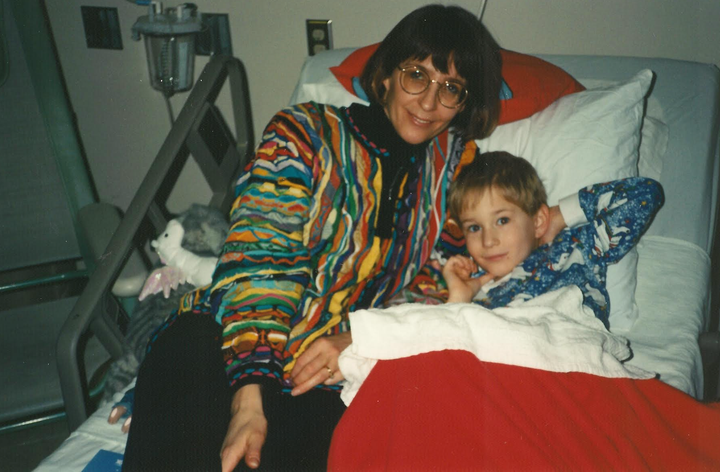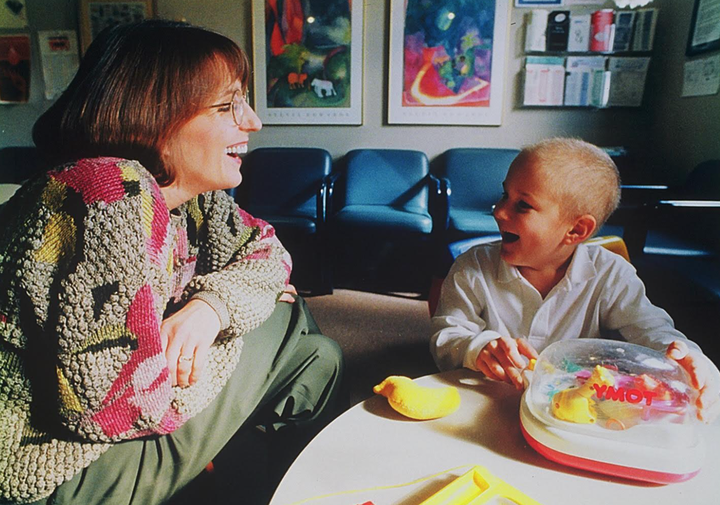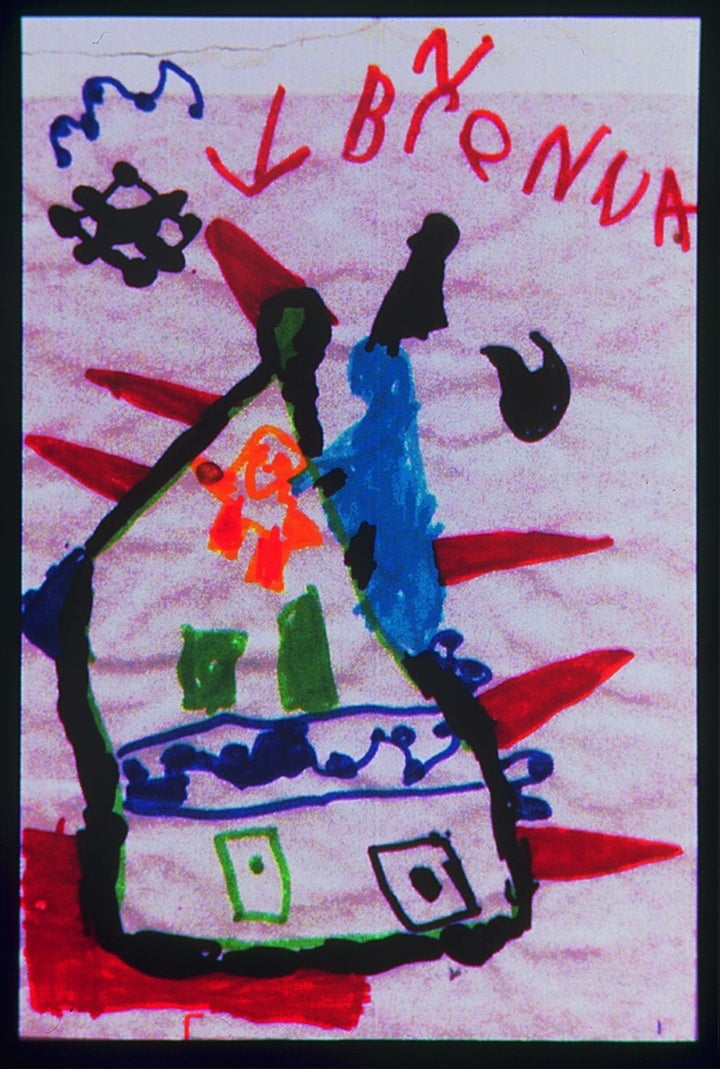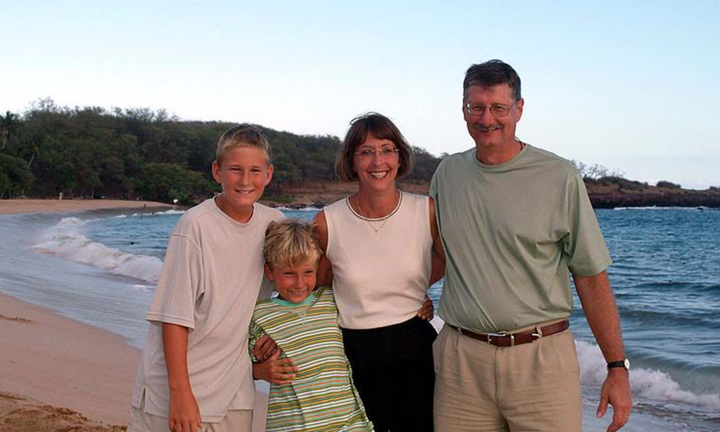
I was a cancer nurse. I thought I knew what living with cancer was about. Then my 4-year-old son, Brennan, got leukaemia.
“Two months is the norm,” his oncologist said that fateful January day, describing how long it usually takes to diagnose leukaemia in kids. But I’m not the “normal” parent, I chided myself at 2 a.m., as I tossed on the crunchy vinyl couch in his hospital room. I had been a cancer nurse, researcher and educator for 15 years. I should have seen the signs.
To be fair, the symptoms didn’t shout “leukaemia.” They rarely do. And I wasn’t a diagnostician. I had a Ph.D. in nursing, and my title was “Dr.,” but I cared for and offered interventions to patients with cancer after diagnosis, to help them get through their experience. Even so, I felt responsible for missing my son’s symptoms.
The leg pains started at Halloween. Cloaked as a ghost, Brennan sat rocking on two legs of the kitchen chair, waving his arms as he talked to Grandma on the phone about the first bag of Halloween candy he was old enough to remember. He didn’t tell her about the leg pains that had flickered on and off throughout the day, so maybe they weren’t so bad.
Then came the fevers, and on some days, the sharp abdominal pain around his belly button, both always gone after 12 hours. It was easy to ignore symptoms that went away. By Christmas, the purple velvet robe he wore, as the King carrying frankincense to baby Jesus in the preschool reenactment, dwarfed his rail-thin body. Even his smile was crooked in the picture. I started to worry. His paediatrician could find nothing wrong.
We expected this to be the last Christmas with my father, so we drove to my family home two hours away, where Brennan curled into a fetal position all day to assuage the pain. That evening, he insisted on trying out his new ice skates, a coveted Christmas gift. He fell, got up, and fell again, over and over, until he threw up his hands and shouted, “I can’t do this anymore!” We didn’t know then that his haemoglobin was half of what it should have been, and there wasn’t enough oxygen to feed his muscles.
Back home in the new year, we resumed our routines ― until one morning, when his hand shook like an old man’s as he showed me his Lego figure. He scrunched his brow, averted his eyes and silently, swiftly pulled the toy back and tucked it into the pocket of his sweatpants. Neither of us said a word. I wish that I had swooped him up in my arms, held him close and asked him how he was feeling. Instead, I gave him a quick, reassuring hug and set off for work. Our nanny paged me at noon, concerned. “Make me an appointment,” I said, relieved to be taking action.

Brennan’s leukaemia took two months and nine days to progress to the point where it could be detected in a routine blood test. This didn’t affect his prognosis. But waiting one more day might have, and it would have put him in a higher risk category, requiring even more aggressive treatment.
Within six days, acute lymphoblastic leukaemia was confirmed by bone marrow biopsy. We enrolled Brennan in a clinical trial with 2,000 other children, a central line port-a-cath was surgically placed to inject chemotherapy, and he started induction therapy, the first phase of what would be 38 months of treatment.
Although I worked mostly in adult oncology, I knew what to expect regarding treatment options, side effects and how to navigate the health care system. But I had no training as a cancer mom. I felt it was my responsibility to advocate for and guide my family, yet I felt vulnerable like every other parent who fears losing their child. I couldn’t predict or control or even plan for the future, and I couldn’t protect my son from the hurt of having to go through three years of cancer treatment.
While Brennan drew pictures to process and share his feelings, I buried mine. I flew into action, advocating for him and overseeing his care. It’s what I knew. It just seemed so much easier to be the nurse than the mother. I had something to do.
The first day in the hospital, he drew a house with a smiling figure huddled alone in the attic. Outside, a large, blue body reached between red spears jutting from the thick, black roof. “It’s a birdhouse,” he told me. “There is a little yellow bird inside. There is a warning to stay away.”
Two days later he added lights and toys outside. “To look pretty for Mom,” he said. His little yellow bird still hovered in the attic, splattered with red dots, signifying all the pokes it had endured. “The window is the only way in,” Brennan whispered in my ear, giving him some imagined control in his new world.
In that first year of intense treatment, I collected a portfolio of his pictures. He drew his bones with a heart and brain, so they would feel love and know how to “make the right kinds of cells.” He outlined a figure in black and purple, showcasing his own anger bursting to escape, and he gave the Headless Horseman a candle “to help him find his way.” By summer, he drew a flower, standing straight and tall amid the rain and swirls around it. Over the year, my son found courage and strength, despite the invasive, fatiguing treatments and the chaos in his young life.

Over time, we found a new normal. We accepted the uncertainty and the unpredictability; we looked for joy, and created fun. When Brennan was almost 8, he completed his treatment, and we tossed the chemo blanky — our security against relapse — and went about reclaiming childhood. But the years of managing his care, watching for symptoms, planning for every foreseeable event, questioning treatments, investigating options and making tough decisions — all while subduing the loss, worry, anxiety and fear of losing my son — took a toll. I was so busy doing, I didn’t take time to feel. I discovered that emotions may hide, but they don’t disappear.
A decade after the treatment ended, I had a dream in which Brennan died. Friends of his without faces handed me a horse, a dog, a basketball, a football. All stuffed. All white. All memories. I didn’t want them. I didn’t accept them. But I took them. My hands, like robots, dropped each one onto a pile on the white painted ledge of the bay window. I turned back to take the next gift, as if the rhythm of moving back and forth would keep me alive. The next day I saw his body in a coffin in a cloud on top of the hill.
“He’s a survivor!” I screamed into the void. It was as if the memories had weaselled their way into my cells, lurking in my DNA and regenerating insidiously. My son was a childhood cancer survivor, one of 500,000 in the United States. And yet I remained hypervigilant. Why couldn’t I lay these fears to rest?
Whatever we face — cancer, pandemic, death or some other crisis — there can be a temptation to bury our emotions to avoid feeling the discomfort in the moment (for whatever reason). If we do this, we can hide those feelings from our awareness, but not from our subconscious. Emotions encode themselves in the brain’s limbic system, where motivation, long-term memory and the sense of smell reside. The feelings resurface when triggered by a memory, an odour or a new related event. Ultimately, it takes more energy to suppress and control emotions than it does to just feel them in the moment.
When my dream woke me up, my son was scheduled for a routine tonsillectomy. On the 15th anniversary of his leukaemia diagnosis, I sat alone in the muted surgical waiting room and stared at a black heart in the abstract picture on the wall. Fears blurred into one. Memories flooded back, and a torrent of tears caught up with time.
It was time to face my fears of losing my son — to feel them, make sense of them and then let them go. But how?
Some people talk. I started writing. I wrote in the pages of journals, on my computer, on notes scattered here and there. And then I wrote a memoir to make sense of all the scattered thoughts — and feelings. Writing down my thoughts allowed my feelings to show up on the page, separate from my body. Once they had an identity, my cognitive mind could make sense of them, analyse them and find ways to deal with them.

Writing was my first step into awareness. Expressive writing, pioneered by the social psychologist James Pennebaker, is a therapeutic technique of writing about an experience to discover emotional meaning and gain perspective. Writing required patience, effort, time and fortitude, but I felt driven to understand and make sense of events so I could release the hold they had on my psyche. It was safe now. The risk of relapse was behind us.
Still, it was hard. I had to recreate, relive and process all those feelings I’d avoided for the sake of getting through. I learned to be gentle with myself, to forgive myself, to honour the fact that I was a mom with feelings. (Kristin Neff calls this “self-compassion.”) In the process of looking back, of reliving the events surrounding my son’s leukaemia, I learned to face my fears, let go of my expectations for myself — and the guilt at not recognising his symptoms — and be present in the moment, the one I was living now. Forgetting doesn’t heal; remembering does.
Twenty-five years to the week after his diagnosis, my son, now six and a half feet tall, sat next to me at a local indie bookstore for my first book signing of “Standing at Water’s Edge: A Cancer Nurse, Her Four-Year-Old Son and the Shifting Tides of Leukaemia.” Brennan told the audience his takeaway from our story: No matter how prepared you think you are, you can never be prepared emotionally. Knowledge alone won’t get you through.
There is no training to be a cancer mom. I had to learn to live from my heart as well as my head.
Janice Post-White is a cancer nurse, researcher, writer and mother of a childhood cancer survivor. Her memoir, “Standing at Water’s Edge: A Cancer Nurse, Her Four-Year-Old Son and the Shifting Tides of Leukaemia,” explores her personal and professional insights on survivorship, resilience and healing, and what facing death teaches us about living life. Visit her at JanicePostWhite.com or @jpostwhite on Twitter.